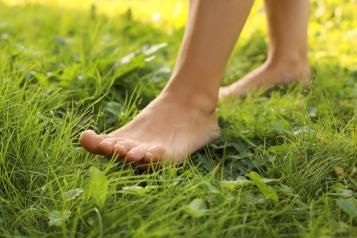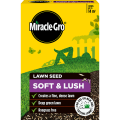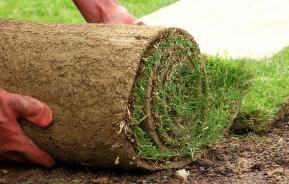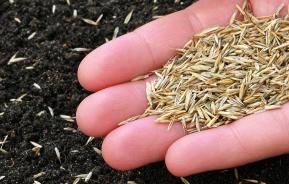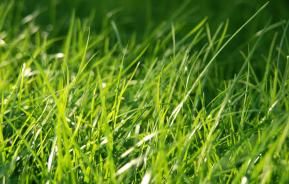
Real grass lawns versus artificial lawns
Trying to decide between fake grass or real grass? Our guide will help you choose
Nothing beats the sensation of sinking your bare feet into cool grass on a summer’s day. And a well-maintained lawn makes the whole garden look good. No artificial lawn can mimic the feel and appearance of real grass, and when the impacts on the environment are taken into account, it’s clear there’s no substitute for a well-tended real grass lawn. Here we compare real grass with artificial turf to help you make the right choice for your garden and lifestyle.
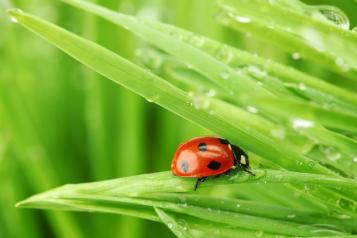
Let’s take a look at the many benefits of real grass
As well as pleasing to the eye, a real grass lawn is good for garden wildlife and our wellbeing.
- You can increase the range of wildlife in your garden with a real lawn which is a habitat for insects and worms - which will attract birds!
- Birds also feed on patches of grass which have gone to seed and on the seeds of common lawn weeds like plantain and dandelion.
- Rainwater drains away more quickly from real lawns, reducing the risk of flash flooding, a growing hazard thanks to climate change and the increased use of stone or concrete slabs to pave outside areas.
- A real lawn acts as a carbon sink: growing grass removes carbon dioxide from the atmosphere and uses it to form new growth through photosynthesis. When dead grass roots decompose into organic matter, they fix carbon in the soil.
- A real grass lawn acts as a natural air filter by absorbing the dust and pollutants we would otherwise breathe in.
- The root systems of a real grass lawn stabilise the soil, helping to prevent erosion in rural areas or where grass is planted on a sloping site.
- Gardens planted with real grass can absorb sound and reduce noise pollution.
- It’s cheaper to establish a new lawn from seed or with turf than to install artificial grass, which varies in price depending on quality.
- The sensation of walking barefoot on real grass can reduce stress and increase wellbeing.
- Mowing the lawn helps to keep you fit!
There are numerous disadvantages to artificial grass
Here we list a few of them, ranging from adverse effects on the environment to the impact on your purse and even your nostrils!
- It stops the worms and other little creatures, which live in the soil beneath a real lawn from feeding on grass clippings and fallen leaves, which helps maintain soil health.
- Other animals, such as solitary bees which make their nests in holes in real lawns, lose out on important habitats.
- Digging out a real lawn to lay an artificial lawn releases carbon dioxide into the atmosphere.
- Making and transporting artificial grass consumes fossil fuels.
- Fake grass is made from manmade plastic materials which can shed fibres and pollute rivers and the ocean.
- Fake grass lawns get hotter than real grass lawns, making them unusable by humans and animals in very hot and dry weather.
- Artificial grass needs replacing after about 10 to 20 years, and only a very few specialised recycling plants are equipped to handle fake lawns.
- It can increase the risk of flooding: heavy rain runs off artificial turf more quickly than real turf and debris accumulated on fake grass can clog drains in heavy downpours.
- Although it doesn’t need mowing, artificial grass isn’t totally labour free. It must be cleaned and kept clear of dust, fallen leaves and twigs from overhanging trees, to prevent a build-up of moss and annual weeds. Some people vacuum their artificial grass to keep it clean.
- Dog urine can build up under artificial turf, causing an unpleasant smell. This can be prevented by cleaning with a specialist enzyme or biocidal cleaning product.
- It’s more expensive to install an artificial lawn than a real grass lawn, whether established from seed or turf.
- Fake grass isn’t suitable for a sloping site: the sand base needed to create an even surface can creep downhill to the bottom of the slope.
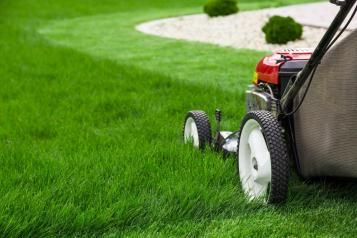
Worried about the possible disadvantages of real grass?
While it might sound like caring for real grass is hard work, with the help of some carefully chosen techniques and products, you’ll find caring for a real grass lawn enormously rewarding and quite simple. Here are a few tips to address any concerns you might have.
- While a real lawn isn’t ready for use on the day it is laid, you can walk on a new grass lawn laid from turf within a week to ten days.
- With regular weeding, mowing and feeding from spring through autumn, your lawn will stay healthy and looking its best. Spending extra time on a couple of lawn jobs in the autumn will give you a healthy lawn next year. Time well spent when you see the positive impact of a well-tended lawn on the overall appearance of your property.
- Consider switching your petrol mower with a cordless mower, powered with a rechargeable battery, to cut down on the use of fossil fuel and make mowing even easier.
- Although grass temporarily turns brown during drought, it’s very resilient and quick to recover when it rains.

When deciding between grass vs artificial turf, it’s important to think about is the effect of your decision on the environment. Choosing real grass will give you an attractive wildlife friendly green space to relax in, especially if you don’t mind spending a little time looking after it. Our range of products, such as Miracle-Gro® Lawn Dressing Enriched Lawn Soil will help you to keep your real grass lawn looking its best at all times.
